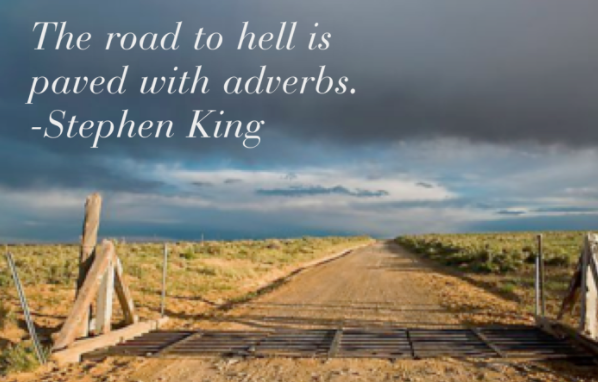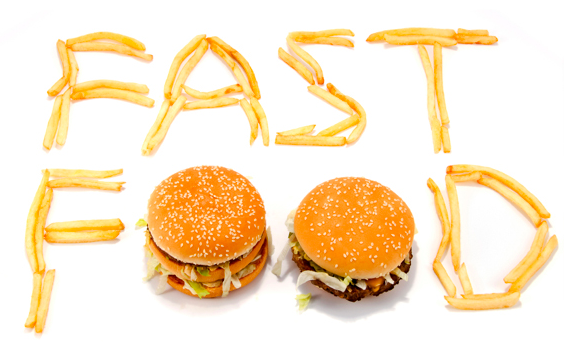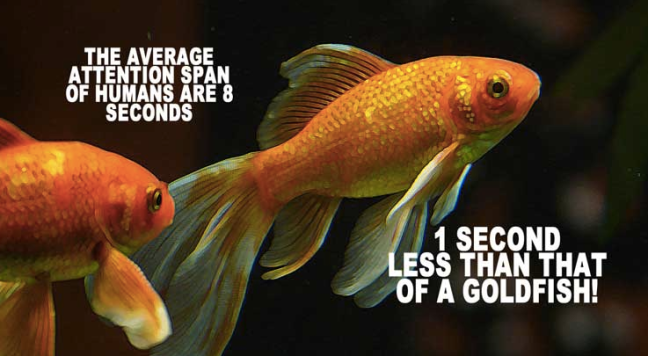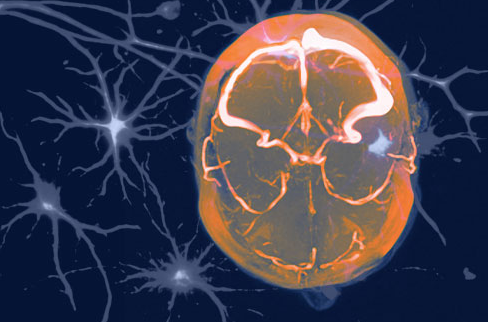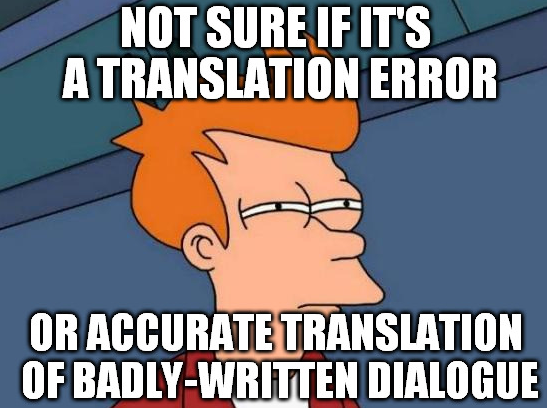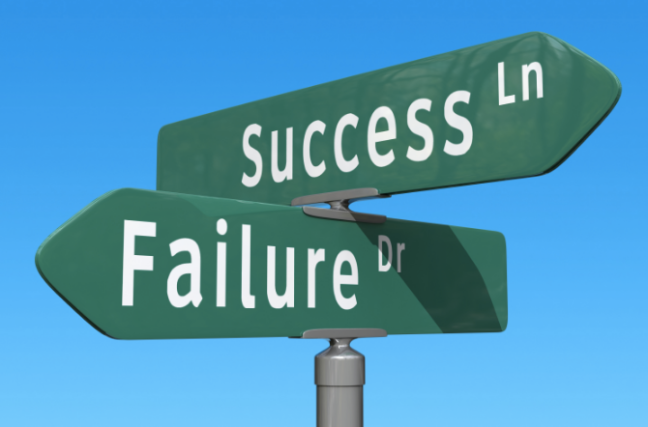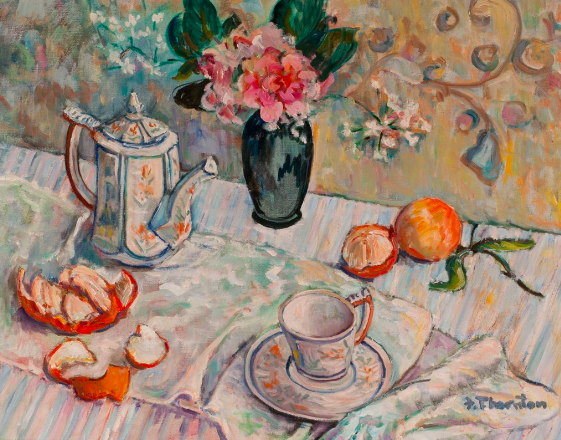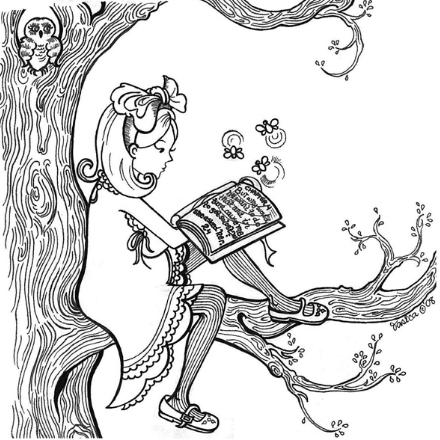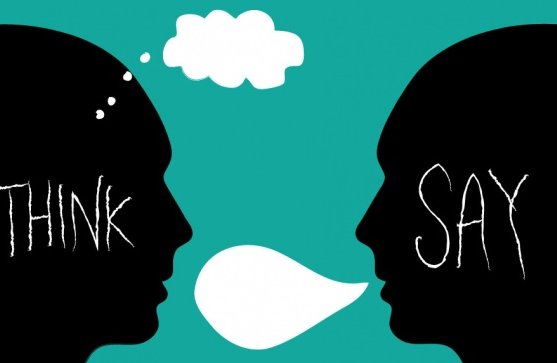Word Count: 2219
Word Count without quotes: 2102
PROOFREADING
DOCUMENTATION
INTEGRATION OF VERBAL AND VISUAL RHETORIC
Found: Rabbit Hole amidst Occipital and Temporal Lobes
Who looks outside, dreams; who looks inside, awakes.
-Carl Jung, Memories, Dreams, Reflections
Kids, Kindergarten through 5th grade, all packed together during one Sunday School. Each child produced it’s own soundtrack of noise, and it all combined into a hurricane of nonsense rushing my ears. The rush of colors from the costumes of the biblical performers dizzied me, and I soon backed myself in a corner underneath a table. I looked down at my hand in front of my face and it was as though it was a stranger’s hand. I was experiencing mind-body disconnect. As I looked into the crowd from my crouched position underneath the table, I felt my neck crane against the hard wood table. I was growing bigger than the rest of the room. Next, I shrunk, “shutting up like a telescope.”[i] I moved from the Sunday School room down to the Sanctuary in a whirl of a distorted universe and fainted outside the church coffee room. My parents drove me to the hospital. After some blood tests and an MRI, the doctor said I simply experienced a migraine with aura, specifically one that was referred to as Alice in Wonderland Syndrome.
The “diagnosis” began my fascination with the book and the character because my migraines transported me into Wonderland–a world filled with chaos and violence and confusion. I read Alice several times admiring the intricacies of her universe. However, it wasn’t until my philosophy class that I discovered some deeper themes in Alice–the theme of identity as it relates to Descartes’ Dualism, for example. At the time, I was also studying biology, genetics, and psychology. So my Alice wove these subjects together, and I concluded that the thinkers (Carroll) described physical phenomena before they had even been discovered by scientists. Sigmund Freud himself was 9 years-old when Alice in Wonderland was first published. Did Alice inspire his Interpretation of Dreams(she was dreaming on a “golden afternoon” when she first fell into Wonderland) and his theories of the pscyhe, defense mechanisms, ect? Alice provides a rich description of real neurological functions such as Migraines, Dreams, Language, Memory, and Learning.
I want my personal anecdote to mirror the organization of my entire paper with visual distortions, body image distortions, auditory and language disturbances, and dreamy states.
* * *
On a warm afternoon, Alice falls asleep and dreams of Wonderland, but knock on her skull and open it up like a jar of orange marmalade and discover a world both curious and common. One billion people worldwide have fallen into Wonderland, that is, if the world of migraines is synonymous with Lewis Carroll’s Wonderland.[ii] According to recent studies, thirty percent of migraine patients experience two or more of the following neuropsychological phenomena: visual disturbances and illusions, dreamy states, a variety of language disturbances, transient amnesia, body image distortion, auditory, olfactory and gustatory hallucinations.[iii] In comparison, Alice herself witnesses visual illusions with disappearing cats, body distortions with growing different sizes, language disturbances by confusing her favorite poems and phrases, and, most importantly, dreamy states as Alice “half believed herself to be in Wonderland.”[iv] Through the analysis of phenomena associated with migraines and its connection to Wonderland as well as Carroll’s own diary entries describing migraines, one concludes that with the creation of Alice in Wonderland, Carroll pioneered the understanding of the brain and consciousness.
Visual Disturbances and Illusions
Charles Dodgson, better known by his alias Lewis Carroll, records his first migraine experience on the morning of May 23rd, 1885. “I experienced,” he writes, “that odd optical affection of seeing moving fortifications followed by a headache.” These moving fortifications he describes are known as scintillating scotoma, a visual aura that precedes a migraine and is characterized by flickering pixels that partially obstruct the patient’s vision.[v]

Scintillating Scotoma and the Cheshire Cat[vi]
In Wonderland, Alice experiences scintillating scotoma in the form of the Cheschire Cat. The pixel quality of the disappearing Cheshire Cat in the figure above is a Wonderland example of Carroll’s migraine phenomena.
Again, on December 3rd, 1888, Dodgson describes his migraine, “It began with a distinct loss of a large piece of the area of vision of the left eye, the blind patch being in the right hand corner, just where, directly afterwards, the ‘fortifications’ appeared.” [vii]
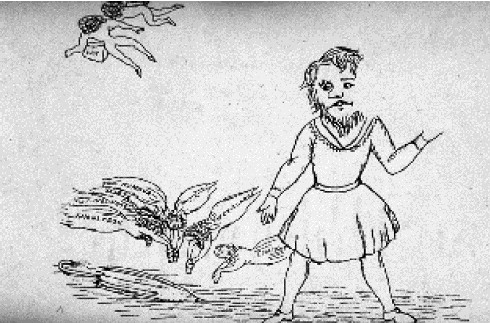
Frontispiece of Mischmasch[viii]
The figure above is taken from the frontispiece of Carroll’s family magazine Mischmasch, which was compiled between 1855 and 1862, a period prior to the publication of Alice in Wonderland. The drawing depicts a partial standing man who is missing parts of the head, shoulder, wrist, and hand. A reasonable portion is erased from the right side of the picture, and the rounded border of the defect resembles a negative scotoma, or blind spot.[ix] In the chapter “Wool and Water” in Through the Looking Glass, Alice experiences a similar blind spot while looking at the shelves: “Whenever she looked hard at any shelf, to make out exactly what it had on it, that particular shelf was always quite empty, though the others around it were crowded as full as they could hold.”[x]
Many migraine patients experience blind spots in the place of people’s faces. This observation gives, “Off with their heads!” an entirely new perspective. Maybe the Red Queen is not angry, she just has a headache.
Carroll’s illustration of the standing man partially obscured by a blind spot provides evidence that he suffered from migraine aura symptoms prior to writing the Alice books.
In regard to Alice in Wonderland Alison Gopnik, a professor of psychology at UC Berkley comments, “It explores so many ideas about whether there’s a continuous self, how we remember things from the past and think about the future – there’s lots of richness there about what we know about cognition and cognitive science” (www.bbc.com). Alice in Wonderland Syndrome was first explored in 1955 by a psychiatrist John Todd. Grant Liu, a neurologist at the University of Pennsylvania in Philadelphia says, “I have heard patients saying that things appear upside down, or even though mommy is on other side of the room, she appeared next to her,” (www.bbc.com).
Body Image Distortion
Reports claim that Carroll himself suffered migraines, so I hope to research these diary entries in the HRC and see how they compare to my experiences, those of others, and Alice, too. Liu suspects the syndrome can be pinned to abnormal activity in the parietal lobes, which are responsible for spatial awareness, skewing the sense of perspective and distance. In further research, neuroscientists are trying to evoke the illusion in healthy subjects – which they think might shed light on the way we create our sense of self in the here and now.
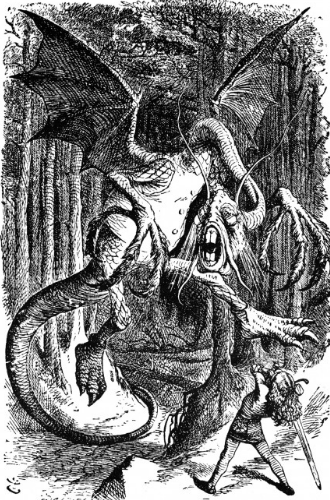
Jabberwocky and Language Learning
Furthermore, in relation to our language functions of the brain, neuroscientists regularly use “Jabberwocky sentences” during brain scans, to show that meaning and grammar are processed quite separately in the brain.
Madness and Mental Illness in Wonderland
Also, let us not forget Carroll’s interpretation of the mental effects of Mercury poisoning in his creation of the Mad Hatter.
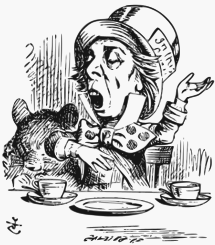
Tenniel’s Mad Hatter
Furthermore, many scholars have compared the decent of Alice into Wonderland to female autobiographical accounts of mental illness, those such as Susanna Keysen’s Girl, Interrupted and Carol North’s Welcome Silence. The argument centers around the claim that many contemporarily women’s memoirs of mental illness represents the experience of a threshold crossing from the everyday to the Real, or alternatively an eruption of the Real into everyday, thus conveying a sense of the porousness of everyday reality and ordinary rational consciousness.
Time and Migraines
Time is a curious character in Wonderland. With respect to the distortions of the sense of time patients report that they felt as if I was going too fast or on the contrary, that every-one was talking too fast, and, therefore, that they were acting too slowly. [xi] As Alice falls down the Rabbit-Hole she, too, describes it as if it will never end. Additionally, in Through the Looking Glass, Alice experiences high-speed flight with the Red Queen.
TIME
MIME
MILE
MILL
MALL
MALT
MELT
Charles Dodgson outlined the rules of his word-puzzle game, Doublets, for Vanity Fair as a puzzle in which “two words are proposed, of the same length; and the Puzzle consists in linking these together by interposing other words, each of which shall differ from the next in one letter only.” Above, I created my own doublet, linking Time and Melt. Melting Time became an iconic figure in Salvador Dalí’s Persistence of Memory. Images of the melting clocks are a reoccurring symbol in Dalí’s work, as they appear in his illustrations of none other than Lewis Carroll’s Alice’s Adventures in Wonderland. Dalí was one of several artists who illustrated the best-selling novel in a series of twelve heliogravures (one for each chapter) and a frontispiece. After all, “what is the use of a book… without pictures or conversation?” Since Dalí’s illustrations of Carroll’s Alice’s Adventures in Wonderland display a unique collaboration between two artists, in two distinct time periods, they transform the reader’s interpretation of the novel from a carefree childhood dream to a corrupt adult nightmare.
The Matt Hatter says to Alice, “If you knew Time as well as I do… you wouldn’t talk about wasting it. It’s HIM.”[1] Dalí, too, personified his clocks, as they possess a fleshy quality that symbolizes mortality. The clock in Mad Tea Party does not appear to be addressing the novel or Dalí himself; rather, this particular illustration embodies the opinion of Carroll at the time.
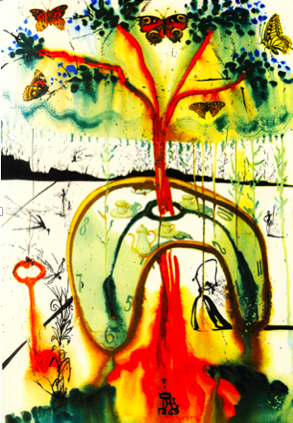
(Mad Tea Party, 1969)[xii]
Heavily influenced by the psychoanalytic theories of Sigmund Freud, Dalí is conceivably suggesting that Carroll, with his infatuation with young girls and fantasies, is incapable of reaching maturity. The tree symbolizes maturation as the butterflies, in their final stages of metamorphosis, circle at the top. Lewis Carroll is the clock, for as Florence Becker Lennon, a scholar in the Freudian school of thought, observes, “his emotional clock … [is] jammed” in incessant childhood.[2] As the caterpillar morphs into a butterfly, our opinion of Carroll has morphed from imaginative dreamer to pedophile, and his work, from fantasy to surreal.
Freud, Jung, and Carroll
Speaking of Alice’s obvious connection to Psychology, Dodgson himself experienced “arrested emotional development and struggled with the demands of adulthood, [and he was] also characterized by an almost desperate longing for the sanctuary of childhood and a return to innocence” (Course Anthology, 976). His own creation of Alice triggered these theories of psychoanalysis that backfired on psychoanalyzing his own work.
Florence Becker Lennon, the author of Victoria through the Looking Glass published in 1945, claims that “Sigmund Freud and Lewis Carroll were tunneling from opposite side… [but] they may have met in the middle,” referring to developments of the subconscious made by both Freud and Carroll.[xiii]
I have a theory that Carroll was a member of the illuminati.
Freud developed his own theories about the presence of migraines. According to Freud, migraines resulted from the toxicity produced by the sexual stimulation when it cannot find sufficient discharge.[xiv]
I don’t know what happened with my documentation, but it went from roman numerals to numbers. I also need to make sure that the only citation that includes Tenniel is for the citations of the Illustrations.
Headache
Hold on. I though migraines were headaches? Does Alice ever experience a headache?
Alice in Wonderland Syndrome
The diagnosis Alice in Wonderland Syndrome was first coined in 1955 by Dr. John Todd, a British psychiatrist.[xv] Those experiencing this particular migraine with aura often relates to Alice changing so many sizes and the nonsense of Wonderland. The name, however, is a convenient advertising ploy for Exedrin.
[1] Carroll, Lewis. Alice’s Adventures in Wonderland. New York, NY: Barnes & Noble,
2004.
[2] Lennon, Florence Becker. Victoria Through the Looking-Glass : The Life of Lewis
Carroll. New York, NY: Simon and Schuster, 1945.
[i] Lewis Carroll. Alice in Wonderland. (New York: W. W. Norton & Company, 2013). Pg. 12.
[ii] Migraine Facts. Migraine Research Foundation. https://migraineresearchfoundation.org/about-migraine/migraine-facts/. Accessed November 15, 2016.
[iii] Peter van Vugt. “C.L. Dodgson’s Migraine and Lewis Carroll’s Literary Inspiration:
A Neurolinguistic Perspective.”(Belgium: CNO Antwerp University, 2000).
[iv] Lewis Carroll and John Tenniel. Alice in Wonderland. (New York: W. W. Norton & Company, 2013). Pg. 96.
[v] “Scintillating Scotoma.” The Free Dictionary. http://medical-dictionary.thefreedictionary.com/scintillating+scotoma. Accessed November 25, 2016.
[vi] Lewis Carroll and John Tenniel. Alice in Wonderland. (New York: W. W. Norton & Company, 2013). Pg. 51.
[vii] Lewis Carroll. The Diaries of Lewis Carroll 1832-1898. (Westport, Conn. : Greenwood Press, 1954). Harry Ransom Center. And RL Green (Ed.) The Diaries of Lewis Carroll. (Greenwood Press, Westport; 1971). Pages 435, 459, 466, 474.
[viii] RL Green (Ed.), The Diaries of Lewis Carroll, Cassell & Co, London (1953)
[ix] Klaus Podoll and Derek Robinson. “Lewis Carroll’s Migraine Experiences.. (Salt Lake City: Elsevier, 1999). Pg. 1366.
[x] Lewis Carroll. Alice in Wonderland. (New York: W. W. Norton & Company, 2013). Pg. 152.
[xi] Rolak, L.A. (1991) Literary Neurologic Syndromes: Alice in Wonderland. Archives of Neurology 48: 649-651.
[xii] Dalí, Salvador. Mad Tea Party. Illustration. 1969. Alice’s Adventures in
Wonderland. Harry Ransom Center.
[xiii] By, Clip Boutell. 1945. “Carroll, Freud perhaps Aimed for Same Goal.” The Washington Post (1923-1954), Apr 01, 1. http://ezproxy.lib.utexas.edu/login?url=http://search.proquest.com/docview/151786818?accountid=7118.
[xiv] J. M. Masson (Ed.), The Complete Letters of Sigmund Freud to Wilhelm Fliess. (Cambridge: Harvard University Press, 1985.) Pg 143.
[xv] Helene Stapinski. “I Had Alice in Wonderland Syndrome.” New York Times. http://well.blogs.nytimes.com. Accessed November 25, 2016.

